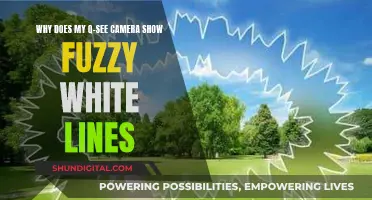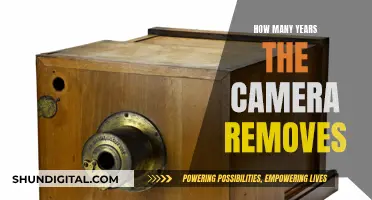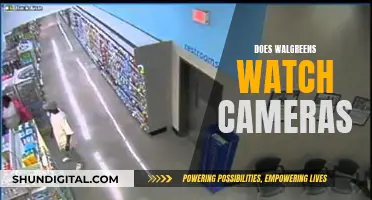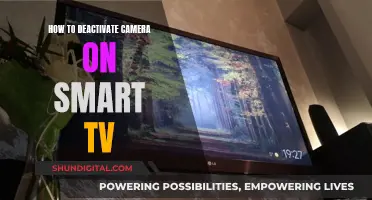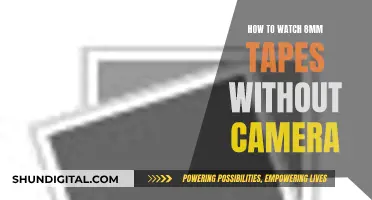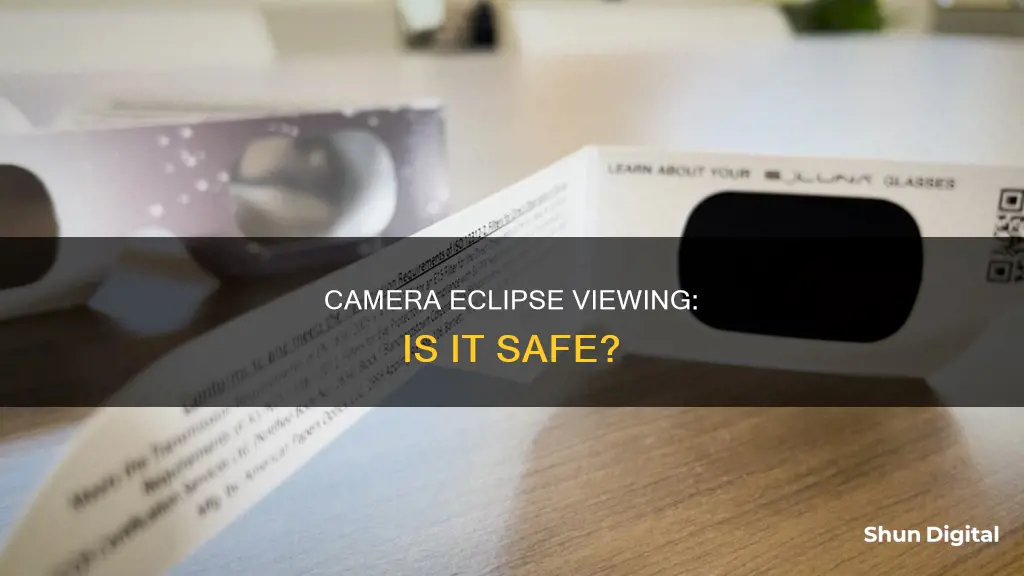
It is unsafe to look directly at the sun during a solar eclipse without specialised eye protection. The sun's brightness can cause severe eye injury. Similarly, it is unsafe to look at the sun through a camera lens without a special-purpose solar filter. According to NASA, an unprotected camera sensor can be damaged if pointed directly at the sun. However, it is possible to use a camera to view a solar eclipse safely by using a special solar filter or eclipse-viewing glasses.
| Characteristics | Values |
|---|---|
| Is it safe to watch an eclipse through a camera? | No, it is not safe to watch an eclipse through a camera without a special-purpose solar filter. |
| What type of filter is needed? | A special-purpose solar filter secured over the front of the camera's optics. |
| Can you use a phone to watch an eclipse? | Yes, but it must have a proper ISO-certified filter, ISO 12312-2. |
What You'll Learn

The use of solar glasses to cover the camera lens
It is well-known that during a solar eclipse, looking directly at the sun without protective gear can cause permanent damage to your eyes. However, did you know that your camera equipment is also at risk of damage? According to NASA, a camera's image sensor could be at high risk if pointed directly at the sun.
To protect your camera, you can use solar glasses to cover the camera lens. Solar glasses are not the same as sunglasses, and it is important to ensure that your solar glasses are not a cheap knock-off. You can carefully use disposable solar eclipse viewing glasses to cover your camera lens. Make sure that the glasses stay in place and block all lenses. You can use rubber bands to secure the glasses over the lens. This method may not be as effective as using a special solar filter, but it can help protect your equipment from damage.
It is important to note that you should only remove any filters during totality, when the moon completely blocks the sun. During the partial phases of the eclipse, always keep your solar filters in place. The American Astronomical Society emphasizes that "special-purpose solar filters must always remain on cameras during the partial phases."
Additionally, you can use a shade 12 or greater welding lens to cover your camera lens. According to NASA, this option is safe for viewing the eclipse. However, some sources recommend using a shade 14 lens to be on the safe side.
While using solar glasses or a welding lens to cover your camera lens can provide some protection, it is important to follow other safety precautions as well. Do not look directly at the sun during the eclipse, and always wear protective eyewear, such as eclipse glasses, when viewing the event.
Switching On: Apple Watch Camera Functionality Explained
You may want to see also

The use of a pinhole projector to view the eclipse
A pinhole projector is a safe and easy way to view a solar eclipse. You can make one at home with a few simple supplies. All you need is a piece of cardboard or paper, a pin, a paper clip, or a pencil.
To make your pinhole projector, start by cutting a small square or rectangular hole in the middle of your cardboard or paper. Then, tape a piece of aluminum foil over the hole. Next, use your pin, paper clip, or pencil to poke a small hole in the centre of the aluminium foil.
To use your pinhole projector, stand with the sun behind you and hold the projector above a flat surface, such as a piece of paper or the ground. The sunlight passing through the pinhole will project an image of the partially eclipsed sun onto the surface, which you can observe safely. The farther away you hold your projector, the bigger your projected image will be.
It is important to remember never to look directly at the sun without proper eye protection, such as eclipse glasses or a special solar filter. Pinhole projection does not mean looking at the sun through the pinhole. Instead, you project sunlight through the hole onto a surface and then view the image on that surface.
You can also get creative with your pinhole projector by poking multiple holes in the foil to make shapes, patterns, and designs. Each hole will create its own projection of the sun, resulting in some neat effects.
Accessing Baby Monitor Cameras: A Guide for Phone Viewing
You may want to see also

The dangers of looking at the sun without protection
It is well known that during a solar eclipse, without protective gear, the sun can cause permanent eye damage. However, many people are unaware of the dangers of looking directly at the sun outside of these events.
The impact of UV light on the eyes
The sun produces ultraviolet light, which is the most damaging to the structures of the eye. With overexposure to UV light, the corneal cells start to crack and blister, much like a regular sunburn. This is known as solar keratitis and results in light sensitivity and pain, with symptoms generally showing up within 24 hours of exposure.
More serious damage: Solar retinopathy
More serious damage can occur when UV light burns a hole in the retinal tissues. This is known as solar retinopathy and can create a small blind spot in the central vision, known as a scotoma. The retina does not have any pain receptors, so you may not feel the damage being done. It may be hours or even days later when people find their vision is blurred or that dark or yellow spots are affecting their sight.
Permanent damage
Solar retinopathy can be permanent and it can occur when someone looks at the sun for less than two minutes. The overstimulated light-sensing retina cells start to release signalling chemicals, causing a flood of chemicals that can lead to tissue damage. While some people do recover, it is possible to be left with permanent visual acuity deficits.
Other risks
Other risks to the eyes from sun exposure include macular degeneration, pterygia, cataracts and pinguecula. These conditions can cause vision loss, a burning or gritty sensation in the eye, blurry vision, and itchy, dry or burning eyes.
Protecting your eyes
To protect your eyes, it is recommended to wear sunglasses that filter out both UVA and UVB light, and a hat with a broad brim. It is also important to never look directly at the sun, especially during a solar eclipse, and to use special "eclipse glasses" or handheld solar viewers if you want to view an eclipse.
Viewing Zmodo Cameras on PC: A Simple Guide
You may want to see also

The use of a welding helmet for eye protection
It is well-known that during an eclipse, without protective gear, looking directly at the sun can cause permanent damage to your eyes. Therefore, eye protection is essential when witnessing an eclipse. While eclipse glasses are the easiest option to safely view an eclipse, another option is to use a welding helmet.
Welding helmets are safe for eclipse viewing. The heavy-duty lenses used in welding helmets are designed to keep out the intense light of welding arcs, and they are more than capable of blocking out the sun's light during an eclipse. Additionally, welding helmets provide a shield for your face, allowing you to observe the eclipse without worrying about eye damage. They are also superior to regular sunglasses in terms of eye protection.
However, it is important to note that not all welding helmets are suitable for eclipse viewing. Most welding equipment found in hardware stores is not dark enough. To safely look at the sun, NASA recommends using a welding helmet with a Shade 12 or higher filter. Philips Safety Products Inc. suggests that Shade 14 is the most recommended rating for solar eclipse viewing, but even then, it should only be used to look at the sun for a limited time.
If you plan to use a welding helmet to view an eclipse, make sure you know the filter's shade number. If it's less than 12, do not use it to look at the sun. Additionally, welding helmets can be uncomfortable and cumbersome to wear for long periods of time. Therefore, it is recommended to use them in conjunction with other safety measures, such as proper eye protection and avoiding prolonged exposure to direct sunlight.
Syncing iPad Camera to MacBook: A Step-by-Step Guide
You may want to see also

The use of a solar filter for your camera
It is unsafe to look at a solar eclipse with the naked eye, and the same goes for your camera. The sun's intensity can damage your equipment if you do not have the proper gear.
To protect your camera, you will need to use a solar filter. These filters are designed to sufficiently dim sunlight and protect your equipment from IR and UV radiation. They come in various options:
- Filter Sheet: Mylar white-light solar filters come in different shapes and sizes. Some are round and have tether holes to secure to your camera and/or lens.
- Screw-On Filter: These white-light filters thread onto your camera lens like a standard threaded filter and are designed for solar observing.
- Intermediate Filter: These are designed for solar imaging and mount between your lens and your camera.
It is important to note that you should not use a neutral density (ND) filter as a substitute for a solar filter. While some ND filters are marketed for solar photography, solar filters are the only ones designed specifically for viewing the sun.
Additionally, be sure to follow general safety guidelines when photographing a solar eclipse. Avoid looking at the sun through an optical viewfinder, and do not use your flash. It is also recommended to practice photographing the sun before the eclipse to ensure you are prepared for the real event.
Hacking Cameras: Watch Dogs Style Guide for Beginners
You may want to see also
Frequently asked questions
No, it is not safe to watch an eclipse through a camera without a special-purpose solar filter.
Watching an eclipse through a camera without a filter can damage the camera sensor. It can also cause severe eye injury if you are using the viewfinder.
You need a special-purpose solar filter that complies with the ISO 12312-2 international standard.
You can buy solar filters from specialist astronomy shops and welding supply companies.
Yes, but only with the proper filters. You can also use your phone to watch livestreams of eclipses or to project an image of the eclipse using a pinhole projector.



